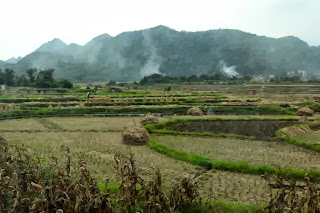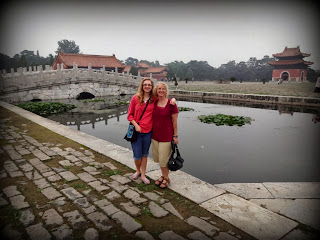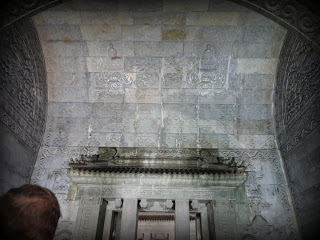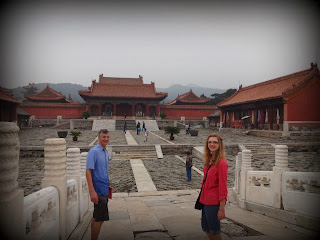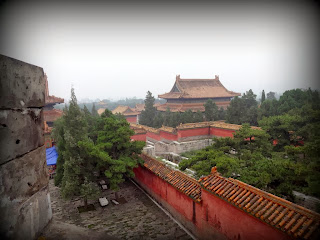Alice, Rachel and a 15-year-old Miao girl in full costume at Datong. Her grandmother sat watching. This village was the "short skirt" Miao, as opposed to the "long skirt" Miao.
It was a cool morning, so the girl had leggings on.
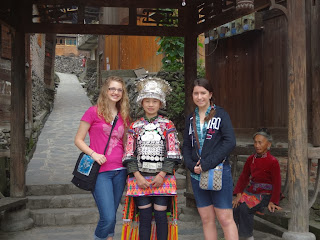
Then the grandmother showed us what she does in the village--weaving.
She was so fast! Notice the new washing machine, but the window was the
major light source.
One of the big male pastimes is fighting bull water buffaloes.
This one might have been on his way to a fight, or just off to a new owner.
The Miao do not eat beef of any kind--cattle are sacred, after a fashion.
Terraced rice paddies that have been cultivated for several hundred years.
The rice is planted and harvested by hand. In one location,
we noticed a new-looking rototiller being used. These plots are too small for a tractor
but a rototiller is far better than a foot and a shovel! It was probably purchased with the help of a micro-loan.
At the village our guide was from, everyone left off the work of the harvest to greet us in their traditional dress, with a rice wine ceremony. Kevin had alerted the guide on the first day that our group (all LDS) did not drink alcohol, so the village used Sprite for the ceremony.
The only problem was, they used the pitchers that have been used for rice wine for years, and the Sprite didn't taste like usual! It burned a little as it went down and had a sharp flavor.
So I guess I kind of know how rice wine tastes...
I priced one of those silver head-dresses in one shop, and it was about $2500.
Miao folk dances. The musical scale is 5 notes. Interesting!
The final dance invited us all in.

Such a bunch of cute girls!
Harvested corn hung off of every building, and made a great backdrop
for a happy couple.
A woman using a scythe to harvest the rice. I don't think I'd be happy squishing around in the mucky water and mud! The people put small fish in the paddy in the spring, and then harvest them after the rice is out of the way as the water dries up.

I loved the straw sheaves. It reminded me of a fairy house.

The Guiyang river walk might not be as unique as the San Antonio one, but it was really nice!
Well-lit, with a beautiful pagoda at one end and city lights reflecting in the water.
It was probably best seeing it at night. (At least that's been my experience looking at rivers in cities in China--not pretty.)
After the first day, we had low clouds, haze, fog, and even rain.
The vista was diminished, but the steepness of these limestone mountains is breath-taking.
Across Heavenly Lake, and into the Dragon cavern.
"Watch your head" was the instruction given before the boat ride. Yeah, right! These huge stalactites were just about head-high and the boat pilot liked to take us right under them.
But we were wise, and no one bumped their head.
And in true Chinese fashion, because a cave isn't amazing enough,
there was a laser light show in one cavern.

Kevin vs. the Dragon.
Huangguoshu Falls. I was expecting some awesome name, but it just means "yellow fruit tree" because there are some in the area (I'm not sure which fruit--I did see a couple of banana trees).
The largest falls in Asia. For those who've seen Yellowstone Falls, or Mesa falls, or especially Niagara, this was underwhelming, along with the fact that we had to be there by 7:30 in the morning to avoid the crowds. The day before, so many cars were in the national park that a traffic jam occurred and many did not get out until late that night.
We did get to walk around and go behind the falls. That was fun. And wet.
And it rained.
Chinglish.

After riding an escalator back up to the top of the canyon (yes! an escalator!)
we had to wait for our bus. This enterprising gentleman had fresh "bell" peppers for sale
right off the plant on his back.
Another minority group. These used embroidery instead of silver for their head-dresses.
I don't know how such a hat became the norm.
We also got to watch a village "opera", which means it was a dramatic presentation. The bad guys are distinguished by having bigger noses. (Like westerners have bigger noses?) Fortunately, it only lasted 10 minutes, and wasn't even closely related to Beijing Opera. That stuff is unendurable!
The second falls.
And a great time was had by all!





















